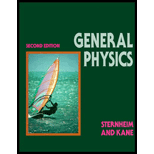
(a)
The energy required to transfer one electron from
(a)
Answer to Problem 1E
The energy required to transfer one electron from
Explanation of Solution
The energy required to transfer one electron from
Write the expression for transfer on electron from
Here,
Conclusion:
Substitute
Thus, the energy required to transfer one electron from
(b)
The electric potential energy.
(b)
Answer to Problem 1E
The electric potential energy is
Explanation of Solution
Coulomb force is the amount of force between two point charges, if the point charges are equal in magnitude and sign then the forces are repulsive in nature and if the charges are opposite in nature, the force between the two charges will be attractive in nature.
Eelctric potential energy is the potential energy that results from coulombic forces.
Write the expression for the electric potential energy for the charge
Here,
are the point charges and
Conclusion:
Substitute
Thus, the electric potential energy is
(c)
The energy required to separate the sodium chloride molecule to its constituents.
(c)
Answer to Problem 1E
The energy required to separate the sodium chloride molecule to its constituents is
Explanation of Solution
The total energy of the molecule is the sum of the required energy to transfer one electron from sodium to chlorine and the potential energy.
Write the expression for total energy that is the sum of transfer on electron from
Here,
Conclusion:
Substitute
Thus, the energy required to separate the sodium chloride molecule to its constituents is
Want to see more full solutions like this?
Chapter 29 Solutions
General Physics, 2nd Edition
- Consider the HCl molecule, which consists of a hydrogen atom of mass 1 u bound to a chlorine atom of mass 35 u. The equilibrium separation between the atoms is 0.128 nm, and it requires 0.15 eV of work to increase or decrease this separation by 0.01 nm. (a) Calculate the four lowest rotational energies (in eV) that are possible, assuming the molecule rotates rigidly. (b) Find the molecules spring constant and its classical frequency of vibration. (Hint: Recall that U=12Kx2.) (c) Find the two lowest vibrational energies and the classical amplitude of oscillation corresponding to each of these energies. (d) Determine the longest wavelength radiation that the molecule can emit in a pure rotational transition and in a pure vibrational transition.arrow_forwardShow that the moment of inertia of a diatomic molecule composed of atoms of masses mA and mB and bond length R is equal to meffR2, where meff = mAmB/(mA+mB).arrow_forwardFor the free electrons in a solid, what is the value of the E/EF ratio knowing that the occupancy factor of the energy level E is equal to 0.05 at a temperature such that kT=EF/4? (NOTE: EF is the Fermi energy) a) 3,65b) 4,20c) 0,26d) 1,74e) 0,04arrow_forward
- Assume that the total volume of a metal sample is the sumof the volume occupied by the metal ions making up the lattice andthe (separate) volume occupied by the conduction electrons. Thedensity and molar mass of sodium (a metal) are 971 kg/m3 and 23.0g/mol, respectively; assume the radius of the Na+ ion is 98.0 pm. (a)What percent of the volume of a sample of metallic sodium is occupiedby its conduction electrons? (b) Carry out the same calculationfor copper, which has density, molar mass, and ionic radius of8960 kg/m3, 63.5 g/mol, and 135 pm, respectively. (c) For which ofthese metals do you think the conduction electrons behave morelike a free-electron gas?arrow_forwardWhat is the probability that, at a temperature of T = 300 K, an electron will jump across the energy gap Eg (= 5.5 eV) in a diamond that has a mass equal to the mass of Earth? Use the molar mass of carbon in Appendix F; assume that in diamond there is one valence electron per carbon atom.arrow_forwardWhen a photon enters the depletion zone of a p-n junction, the photon can scatter from the valence electrons there, transferring part of its energy to each electron, which then jumps to the conduction band. Thus, the photon creates electron–hole pairs. For this reason, the junctions are often used as light detectors, especially in the x-ray and gamma-ray regions of the electromagnetic spectrum. Suppose a single 662 keV gamma-ray photon transfers its energy to electrons in multiple scattering events inside a semiconductor with an energy gap of 1.1 eV, until all the energy is transferred. Assuming that each electron jumps the gap from the top of the valence band to the bottom of the conduction band, find the number of electron – hole pairs created by the process.arrow_forward
- The Fermi energy of aluminum is 11.6 eV; its density and molar mass are 2.70 g/cm3 and 27.0 g/mol, respectively. From these data, determine the number of conduction electrons per atom.arrow_forwardAt what temperature do 1.30% of the conduction electrons in lithium (a metal) have energies greater than the Fermi energy EF, which is 4.70 eV?arrow_forwardGold has an atomic mass of 197 u, a density of 19.3 x 10^3 kg/m^3, a Fermi energy of 5.54 eV, and a resistivity of 2.04 x 10^-8 ohms. Estimate the mean free path in atom spacings between collisions of the free electrons in gold under the assumption that each gold atom contributes one electron to the electron gas.arrow_forward
 Modern PhysicsPhysicsISBN:9781111794378Author:Raymond A. Serway, Clement J. Moses, Curt A. MoyerPublisher:Cengage Learning
Modern PhysicsPhysicsISBN:9781111794378Author:Raymond A. Serway, Clement J. Moses, Curt A. MoyerPublisher:Cengage Learning Physics for Scientists and Engineers with Modern ...PhysicsISBN:9781337553292Author:Raymond A. Serway, John W. JewettPublisher:Cengage Learning
Physics for Scientists and Engineers with Modern ...PhysicsISBN:9781337553292Author:Raymond A. Serway, John W. JewettPublisher:Cengage Learning

